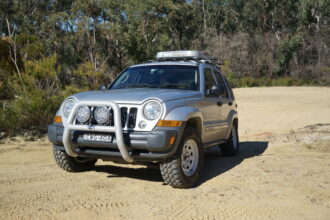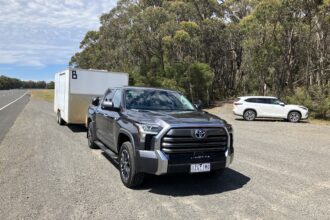Mazda’s all-new BT-50 is finally in showrooms… but why would you buy it over the Isuzu D-MAX with which it shares its DNA? We get behind the wheel to find out.
Unless you’ve been hiding under a rock, you’d likely know that the all-new Mazda BT-50 is based on the same platform as the all-new Isuzu D-MAX. While Isuzu launched its version of this all-new ute in August, Mazda has had to wait until now to make its version available to the public.
While Mazda has had input into the development of the new BT-50, particularly when it comes to exterior and interior styling, everything beneath its unique bodywork is 100 per cent Isuzu. In fact, Mazda had no input at all in the vehicle’s chassis; the driveline, the suspension and the steering tune have been completely developed by Isuzu. But this is no bad thing; we’ve tested a couple of iterations of the new D-MAX including the mid-spec LS-U and the top-spec X-Terrain, and we reckon Mazda can rest assured that Isuzu has done a good job in developing this ute.

Nevertheless, the proof is in the pudding as they say, so we thought we’d better get behind the wheel of the all-new BT-50 to see what it’s like for ourselves.
The variant tested here is the base-spec BT-50 XT Dual Cab Pick Up auto, which lists at $53,260 plus on-road costs. Mazda Australia expects the XT model grade will make up 59 per cent of BT-50 sales, with 68 per cent of customers opting for a Pick Up body style, 84 per cent of customers going for the auto transmission and 89 per cent of customers choosing the 4X4 driveline, so the spec of our test vehicle is undoubtedly going to be the most popular variant in the BT-50 line-up.
What do you get for your money?
Like Isuzu, Mazda offers the full gamut of safety kit across the all-new BT-50 line-up, so even in lowly XT trim, the BT-50 scores eight airbags (including a centre airbag), ABS, Attention Assist, Automatic High Beam (AHB), Autonomous Emergency Braking (AEB), Blind Spot Monitor (BSM), Dynamic Stability Control (DSC), Emergency Lane Keeping (ELK) – Overtaking, Emergency Stop Signal (ESS), Hill Descent Control (HDC), Hill Launch Assist (HLA), Lane Departure Warning (LDW), Lane Departure Prevention (LDP), Lane-keep Assist System (LAS) (auto only), Locking Rear Differential (LRD), Rear Cross Traffic Alert (RCTA), Reverse Camera, Roll Over Protection (ROP), Speed Assist System, Traction Control System (TCS) and Turn Assist.

Other than a dash of chrome on the grille surround, a body-coloured rear bumper and 17-inch alloy wheels, the exterior of the all-new BT-50 XT looks quite understated, especially on our test vehicle with its white paint and the absence of side steps on this model grade. And while the XT’s interior trim is a basic dark grey colour, the neat dash design with decent-size 7-inch colour touchscreen, multi-information display and use of high-grade trim and materials belie the spec level, as do some upmarket features like wireless Apple CarPlay, USB Android Auto, DAB+ digital radio, reverse camera, front and rear USB charging ports and rear air conditioning vents. Basically, it feels like a base-spec ute with much more than just basic kit.

For the record, the equivalent Isuzu D-MAX is the LS-M Crew Cab Ute auto, which lists at $53,000, undercutting the all-new BT-50 XT Dual Cab Pick Up auto by just $260, and while there are some minor equipment differences between the two, choosing between them will likely come down to styling preference, dealer location and warranty. Regarding the latter, the BT-50 is covered by a 5-year/150,000km warranty while the D-MAX has a 6-year/150,000km warranty.
What’s it like inside?
Despite a lack of lumbar adjustment, the driver’s seat is quite supportive. It offers good height and fore/aft adjustment and the steering wheel has tilt and reach adjustment.

The 7-inch screen is bright and vibrant, and the wireless Apple CarPlay will please those with an iPhone. Those with an Android device will have to use the USB port to connect.
Instruments and controls are easy to read and logically positioned; the air conditioning controls are big and easy to use, there are large buttons on the centre console for the rear diff lock, hill descent control and parking sensors, and the steering-wheel buttons are likewise big and intuitively positioned. The only downside? There are no volume or tuning knobs for the sound system – just buttons.
Front and rear occupants get big pillar-mounted grab handles, and there are plenty of storage spaces around the cabin including a small centre console bin, centre console cup holders, large door pockets with bottle holders, a twin glovebox and small bins beneath the rear seat accessed via a 60/40 split base.

Rear-seat occupants get reasonable width and good leg room, and while the seat base is quite flat and the backrest quite upright, it’s comfortable enough. There’s no fold-down arm rest in the rear seat of the XT, which means the centre position is reasonably comfortable to sit in. There are rear air conditioning vents, a small phone holder, a USB port and a coat/shopping bag hook, while the outer seats have ISOFIX points and the centre seat has a top-tether child seat anchor.
Practicalities
There’s no assistance for the manually lockable tailgate but it’s not too heavy. The tub has four tie-down points on the walls but there’s no lighting or 12V power.

To the engine bay, the bonnet is supported by a stay rather than struts, and there’s no light under there. The engine sources its air through a forward-facing intake at bonnet height, so a snorkel should be high-up on your priorities list when ordering accessories if you plan on driving in dusty conditions or tackling water crossings (Mazda will happily sell you an OE snorkel – see ‘Genuine Accessories’ below). The alternator is at about mid-height in the engine bay and if you want to fit an auxiliary battery up front you’ll have to move things around a bit; alternatively, a slimline Lithium battery like those from Baintech will fit behind the rear seat.

What’s it like on the road?
Unsurprisingly, the Mazda BT-50 is just like the Isuzu D-MAX on the road, other than the view from the driver’s seat that exhibits a Mazda badge on the steering wheel and a slightly different bonnet profile.
The 3.0-litre four-cylinder turbo-diesel engine makes a claimed 140kW at 3600rpm and 450Nm from 1600-2600rpm, which is down 7kW and 20Nm on the previous generation Ford-developed Mazda BT-50, which ran a 3.2-litre five-cylinder turbo-diesel engine making a claimed 147kW at 3000rpm and 470Nm from 1750-2500rpm. But on-road performance doesn’t suffer from the lower output thanks to the abundance of bottom-end torque and the effectiveness of the quick-shifting and smooth six-speed automatic transmission. In fact, the new BT-50 feels a bit quicker on the road than the old one, and there’s always plenty of grunt on tap for hill climbs and overtaking.

Although there’s a bit of diesel clatter at idle, the engine is remarkably quiet and refined once on the move; on the open road it’s barely audible when cruising, although it gets a little noisier when you put your foot down. Wind and road noise are also well suppressed.
On-road ride and handling is impressive. The electric-assist power steering is light at low speeds and becomes progressively heavier as speeds increase, and the steering feels direct and responsive, while body roll is well controlled when cornering. The Lane-keep Assist (LAS) and the Lane Departure Prevention (LDP) systems do a good job at keeping you in your lane without feeling overly aggressive, and the active cruise control does a great job at maintaining the set distance to the vehicle in front while also ensuring vehicle speed doesn’t increase too much on downhill runs.
Unladen ride quality is good for a ute and suspension sag isn’t excessive when loaded. For the record, in this BT-50 XT Dual Cab Pick Up auto spec, payload capacity is 1090kg, while the BT-50 offers a class-average 3500kg maximum braked towing capacity.

The 255/65R17 Dunlop Grandtrek AT25s work well on the road; they are quiet and provide good grip, both in dry and wet conditions. They also worked okay on gravel roads, although Light Truck ATs or MTs would be a better choice if you were going to do a lot of dirt-road driving.
And how about off-road?
The BT-50 is reasonably capable off the road, thanks to an effective electronic traction control system and the inclusion of a standard rear diff lock. It offers reasonable wheel travel and decent ground clearance (235mm), although ramp-over angle (23.3°) isn’t great due to the long 3125mm wheelbase. Approach angle is good at 30° and departure angle isn’t bad at 23.9°, but you’ll have to be careful that the painted rear bumper doesn’t catch on anything when exiting gullies or dropping of rock shelves.

Low-range gearing is low enough for steep climbs although you’ll need to dab the brakes or engage the HDC on steep descents.
Mazda claims an 800mm wading depth for the BT-50 but, as previously mentioned, the engine’s forward-facing air intake looks like it could easily take in a big gulp of water if you went too deep, too fast.
Genuine accessories
Mazda Australia has developed a range of more than 100 accessories to suit the new BT-50, from bull bars and snorkels to tub liners and hard-tonneau covers and sports bars to canopies.
“We’re excited by what we’ve got,” Mazda Australia marketing manager Alastair Doak said. “It’s been fun to sit down with suppliers and design and engineer products, especially bull bars, and we worked closely with ARB and others to design products for Australian conditions, for Australian customers.”

As well as individual accessories, Mazda will offer a range of accessory packages. The ‘Boss Adventure Pack’, for example, will include a Black Steel Bull Bar with Hoops, Lightforce Driving Lights, Electric Roller Tonneau Cover, Black Sports Bar, Sports Bar Adaptor Kit For Tonneau Cover, Tub Racks, Roof Platform and Black 17-inch Alloy Wheels for a tad over $13k.

You will even be able to buy ARB OME suspension upgrade kits through your Mazda dealer, complete with BP-51 internal-bypass adjustable dampers.
For more details on BT-50 genuine accessories see this link.
Summary
There’s no doubt the new Mazda BT-50 is a great 4×4 ute but the big question is, why would you buy one over the Isuzu D-MAX? As mentioned, the decision will likely come down to personal preference, the proximity of dealerships and warranty considerations.
When asked why someone might buy a BT-50 over a D-MAX at the official launch of the new BT-50, Mazda Australia’s Alastair Doak responded, “It’s a credible alternative to a number of utes. We have a long history of being in the ute market, we have a great reputation, we have a great dealer network, we have (competitive) Mazda Finance and Mazda Assured (guaranteed future value) that not all competitors have.”
Fair enough, we reckon.
If you were in the market for an all-new Mazda BT-50 or an all-new Isuzu D-MAX, which would you choose? Tell us in the comments section below.
SPECIFICATIONS – Mazda BT-50 XT Dual Cab Pick Up auto
Driveline
Engine: 3.0-litre four-cylinder turbo-diesel, 140kW at 3600rpm, 450Nm from 1600-2600rpm
Transmission: 6-speed automatic gearbox, two-speed transfer case, part-time 4X4 with locking rear differential
Weights:
Kerb: 2010kg
GVM: 3100kg
Payload: 1090kg
Maximum braked towing: 3500kg
GCM: 5950kg
Dimensions:
Length: 5280mm
Width: 1870mm
Height: 1785mm
Wheelbase: 3125mm
Track: 1570mm front & rear
Ground clearance: 235mm
Wading depth: 800mm
Approach angle: 30°
Departure angle: 23.9°
Ramp-over angle: 23.3°
Price: $53,260 +ORC









